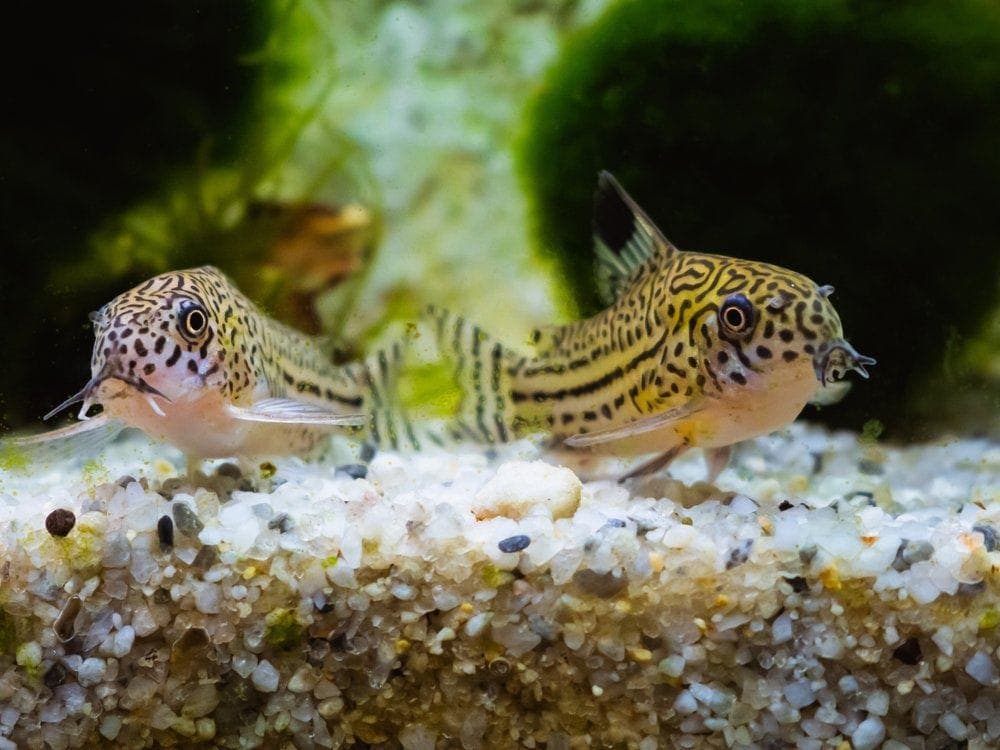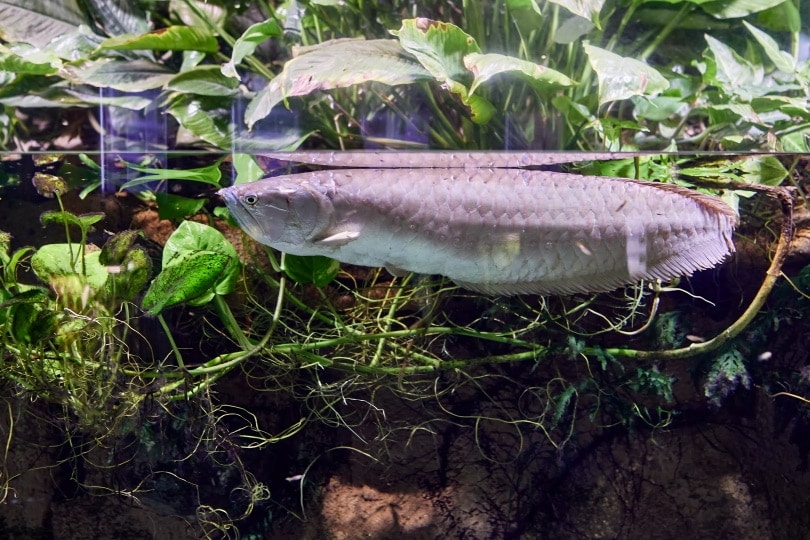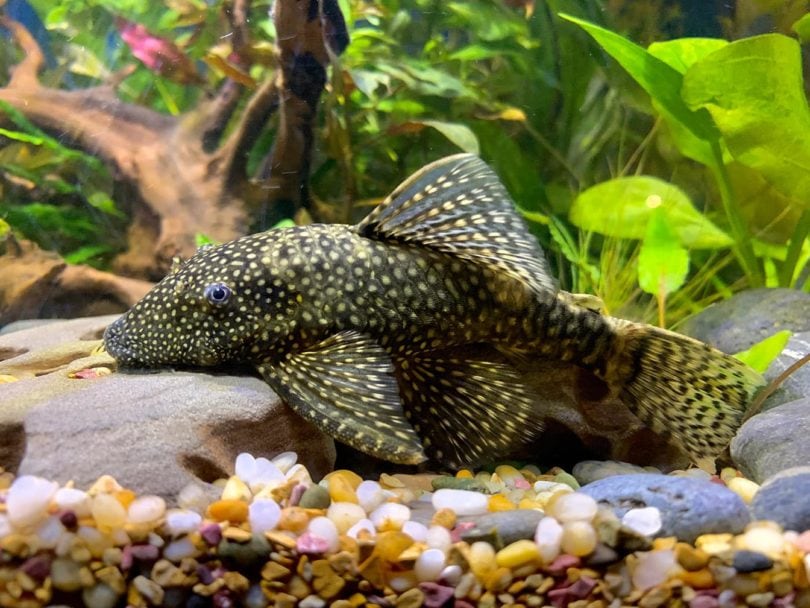Cory Catfish: Expert Care Guide, Pictures, Varieties, Lifespan & More

Updated on
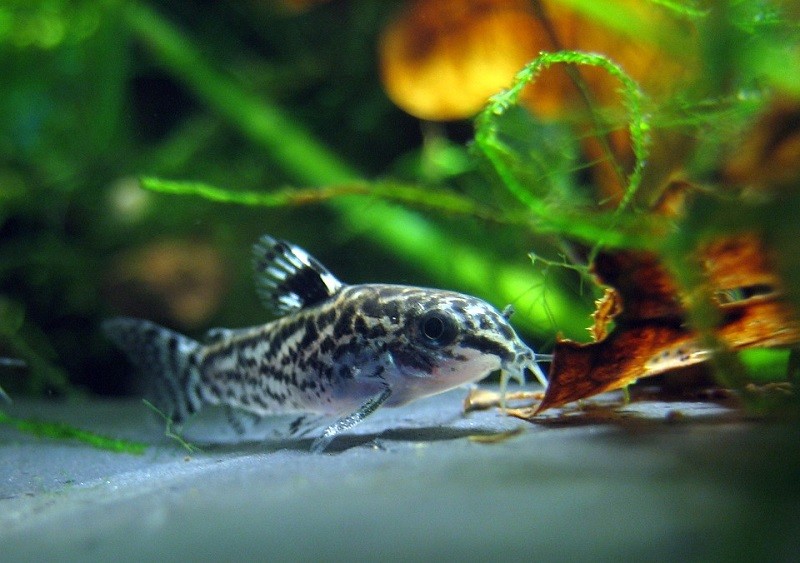
The Albino Cory catfish was one of the first bottom dwellers to be introduced into the aquarium industry. They compromise over 100 species of Corydoras. They are one of the most well-known types of fish in the aquariums with almost a fourth of aquarists in the industry keeping one in their current aquarium. Cory catfish originate from South America in the Andes Mountains and Atlantic Coast and can be found from Trinidad to Argentina. These catfish span in a variety of water columns around the world, with no doubt increasing their popularity amongst every level of the aquarist.

Quick Facts About Cory Catfish
| Species Name: | Corydoras, Brochis and Aspidora |
| Family: | Callichthyidae |
| Care Level: | Beginner/easy |
| Temperature: | 74°F to 80°F |
| Temperament: | Peaceful |
| Color Form: | Peppered, albino, julii, pinkish-white, green, black, and orange. |
| Lifespan: | 3 to 7 years |
| Size: | 2 to 4 inches |
| Diet: | Omnivore |
| Minimum Tank Size: | 30 gallons |
| Tank Set-Up: | Planted, natural |
| Compatibility: | Excellent with other peaceful fish |
Cory Catfish Overview

Cory catfish are freshwater fish that remain on the smaller side of the catfish varieties. This makes them ideal for smaller home aquariums. They come in a variety of fascinations and are good bottom cleaners. Their care is relatively easy, and they can withstand minor novice fish keeper mistakes. They are tropical fish that inhabit shallow and slow-moving streams. They prefer warmer water making them tropical fish in captivity. They find comfort in having a natural aquarium with sand, live plants, and rocks.
These fish can be shy if kept in small groups as they naturally shoal. It is best to keep three or more corys in an appropriately-sized aquarium. They are, however, difficult to breed. These peaceful bottom dwellers feast amongst the substrate with quality bottom-dweller foods. Owners should be extremely cautious when handling cory catfish as their sharp spines contain a mild toxin.
Although Cory catfish prefer soft water, they have adapted to various water chemistry found in home aquariums. These fish make interesting additions to home aquariums and do not grow large like other bottom dwellers such as a Plecostomus. Keep in mind these fish like to huddle in groups amongst plants at the bottom of the aquarium. This means it is essential to provide a safe and suitably stocked home for cory catfish to remain happy and healthy. They use their barbels to forage along the bottom in shoals of 5 or more. They are easily stressed when housed individually and will have a significantly shorter lifespan if their general care requirements are not appropriately met.
How Much Do Cory Catfish Cost?
An individual cory catfish will cost between $2.50 to $6. Although individually they are relatively cheap, it is important to remember these fish should not be kept alone. This means you will have to purchase at least 3 to 5 as a bare minimum. This could mean you will pay anything from $8 to $30 for a minimum shoal number.
The price of Cory catfish varies on where you purchase them from. Pet stores will be cheaper, whereas online will charge a shipping fee that makes the overall sum of money more.

Typical Behavior & Temperament
Cory catfish are social little creatures and are observed in both nature and aquariums and like to hang out with each other. They will occasionally separate for short periods but will always eventually swim back to their shoal to feel safe and secure. Cory catfish are peaceful and make fantastic community shoaling fish in tropical aquariums.
These fish have been observed to occasionally swim to the surface and take a gasp of air. This behavior should not be frequent and is their way of taking in fresh oxygen. By naturally staying towards the bottom of an aquarium, they will not have access to steady amounts of oxygen. By naturally originating from shallow streams, taller aquariums will cause them to surface gulp frequently.
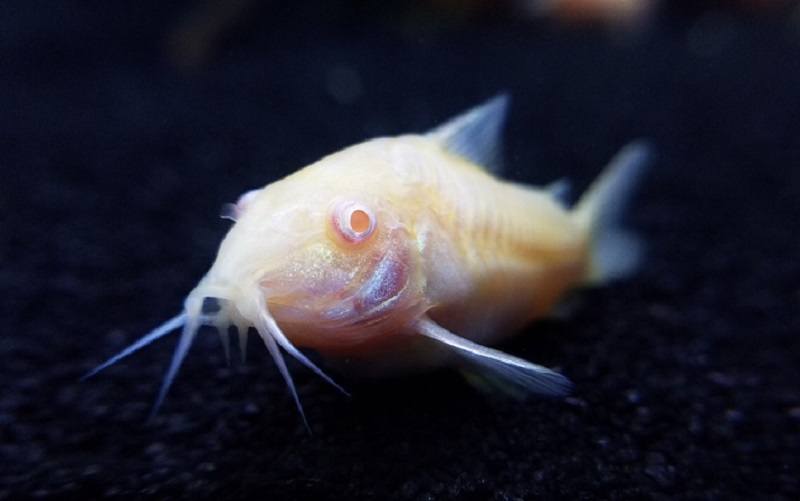
Appearance & Varieties
Cory catfish have a bony spine that is sharp to the touch. They should not be handled with bare hands and will snag human skin, to which they proceed to release the toxin. They come in a multitude of colorations but are not as bright as other species of tropical fish. The most common variety is the albino cory catfish, but there are approximately 170 species in captivity, some of which still need to be scientifically named. They bear sharp spines, dorsal and pectoral fins. This makes them appear as if they have a covering of armor at the top of their bodies. They are small and do not grow more than 5 inches.
With so many varieties and colorations with these catfish, it is difficult to choose which ones to keep in your aquarium. An appealing bonus to keeping cory catfish is that you can keep a variety of colors in one shoaling group. This allows you to house all your favorite cory catfish color variations.
- Bronze: Commonly seen in many pet store aquariums. The bronze cory catfish is a dull rusty color that has shimmering green bands on the side of their bodies.
- Albino: A whitish pink color with red eyes.
- Panda: Multi-colored with a dull white and black.
- Sterba: Displays a primary yellow undertone with small dots along the whole body.
- Julii: Dotted with a straight black line alongside the sides.
- Pygmy: A see-through underside with a dark mix of blue, brown, and grey at the top.
All color variations have the same body shape, an armored boy, dorsal, pectoral, anal fin, caudal, and pelvic fins. Although they are slow substrate grazing fish, they will move fast when startled.
Cory catfish are usually sold at a small size of 1 inch in many fish stores. They will eventually grow to reach 3 to 4 inches, with some show Corydoras reaching 5 inches. The overall adult length you can expect your Cory catfish to reach is based on what you feed them and the size of their tank. Healthy Cory fish will not appear disproportionate or stunted. Abnormally large eyes and a concaving waist is an indication of severely poor health.

How to Take Care of Cory Catfish
- Tank/aquarium size: Due to Cory catfish shoaling in large groups, they need a minimum tank size of at least 30 to 40 gallons. They prefer large peaceful community tanks and are not happy when placed in small or overly tall tanks. The depth of tall aquariums leads to poor oxygen intake. Care should be taken when purchasing the best aquarium for them. The standard rectangular aquarium that is on the shallow side is ideal.
- Water temperature & pH: Cory catfish prefer warm tropical waters. This means they need a stable temperature anywhere between 74°F to 80°F. Their most comfortable temperature is at 77°F. Warmer temperatures make digestion easier. Cory catfish prefer soft water but can survive in moderately higher pH if they are captive bred and not wild-caught. A suitable pH is between 5.5 to 7.0 at maximum.
- Substrate: Due to cory catfishes’ delicate underbodies, they prefer softer substrates such as aquarium sand. They glide along the substrate in search of food and can injure themselves on sharp gravel. Smooth pebbles are the next best option.
- Plants: Cory catfish love to take shelter under low-lying plants. Keeping live leafy plants is a suitable option.
- Lighting: Cory catfish do not like a lot of light. They are found at the bottom of natural streams where minimal light reaches. Using a dimmed bulb on the hood of the aquarium is ideal alongside many plants in an attempt to shield out the light.
- Filtration: Like all species of fish, cory catfish appreciate a good filter that is established with nitrifying bacteria. Ensure the flow is slow in the water as they get stressed easily in strong flowing waters. The filter should filter 5 times the water volume in under a minute.

Are Cory Catfish Good Tank Mates?
Cory catfish are capable of being housed in well-established and decorated tropical community tanks. They get along well with other peaceful fish and do not attempt to start fights with their tank mates. They prefer being housed with middle or surface-dwelling fish who will not interfere with their movements along the bottom of the aquarium. These fish are particularly peaceful and thrive easily even with novice mistakes. They should, however, not be housed with semi-aggressive or primarily aggressive fish species. If you plan to keep more than one bottom-dwelling fish, cory catfish will have to compete with them for food. This can lead to disagreements amongst the species and the aggressive species of bottom-dweller will fight or chase cory catfish away from their food source.
- Tetras
- Glassfish
- Danios
- Molly fish
- Platy
- Swordtails
- Angelfish
- Gouramis
- Fancy Guppies
- Cichlids: Territorial and will chase vulnerable fish.
- Barbs: They tend to nip other fish.
- Plecostomus: Compete for food with cory catfish and become territorial as they mature.

What to Feed Your Cory Catfish
Although cory catfish do a good job at tidying up the bottom of the aquarium, this does not mean they should not be fed a species-appropriate diet once or twice a day. The leftovers that get stuck in the substrate are readily consumed by a cory, but it is important to note that the small particles are far and few. They may seem like they are sucking up food constantly, but they are rarely getting much. Leaving your cory catfish to consume minuscule particles will lead to starvation, inadequate nutrition, and eventually death. It is therefore essential to purchase quality sinking food such as shrimp and algae pellets or algae wafers.
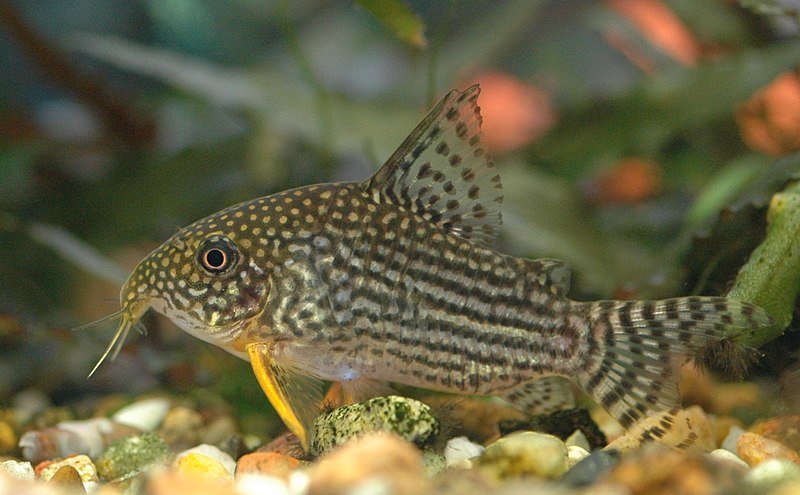
With Cory catfish being primarily omnivores, they appreciate a diet rich in nutritious plants and protein-based foods like bloodworms, daphnia, or brine shrimp. These fish are not picky when it comes to diet choices. Only a small percentage of food should be leftover mid or top dweller fish foods. Growing algae on rocks makes a great nutritious snack for your shoal of cory’s to graze on.
Keeping Your Cory Catfish Healthy
All fish keepers want to provide the best for their fish, this includes keeping them healthy in which they will thrive. Each breed of Cory catfish has a slightly different personal requirement. Although they all fall under the same general care guidelines. Peppered cories prefer cooler temperatures than that of the other breeds. They can tolerate temperatures as low as 68°F. Meeting your cory’s temperature needs is the first step in keeping them healthy. Cory catfish are sensitive to spikes in ammonia, nitrites, and nitrate. Ammonia and nitrate should be kept at 0ppm (parts per million) and nitrates below 20ppm.
Provide a varied diet twice a day for adults and once a day for juveniles. Swap the types of foods you feed in a rotation to ensure your cory is receiving every valuable nutrient to remain in good internal health.
Schedule water changes to keep the aquariums water in good condition. Regularly test the water with a reliable liquid testing kit. Keep your cory in a dim-lit large tank ideally in a group of 5 or more. A stress-free fish is a happy and healthy fish.
Breeding
Cory catfish are difficult to breed. Like most species of fish, cory lays eggs in which the male will fertilize with milt. The eggs will be dispersed along with aquarium plants. The trouble sets in when it comes to getting the eggs to hatch. Some experts struggle to successfully breed their cory catfish. The eggs requirement the exact environmental factors that occur in their natural habitat. The spawning requires two mature cory catfish, a male, and a female. They will have to be induced to spawn via a drop in barometric pressure or temperature. To mimic a rainstorm, it is ideal to do partial water changes and replace that with cooler water over a period. Hold the bucket of cool water high enough above the water to cause a downpour effect. Using a droplet spray bottle works well too for shallow tanks.

Are Cory Catfish Suitable for Your Aquarium?
If you own a peaceful tropical community aquarium that consists of fish on our suitable tank mate list, the cory catfish may be the right bottom dweller for you. If you are looking for a shoaling fish that will add character to the bottom of your aquarium, cory catfish do the job! Your aquarium should not contain gravel as it is too rough for the cory to comfortably forage in the substrate. If you plan to add a cory into a gravel-based tank, it is best to replace it with aquarium sand to prevent injuries, infections, and death. Do not purchase cory catfish if your tank is unable to stock five or more of these fish. A 50-gallon tank is a good start to introduce cory catfish into.
We hope this article has helped you gain knowledge on the beloved cory catfish. With so many variations and advantages of these fish, they make great additions to many aquariums that meet the appropriate requirements.
Check out some of our other top-trending posts:
- 10 Best Saltwater Aquarium Test Kits – Reviews & Top Picks
- How to Build a Plywood Aquarium (Easy DIY Guide)
Featured Image Credit: Alice_Alphabet, Pixabay
